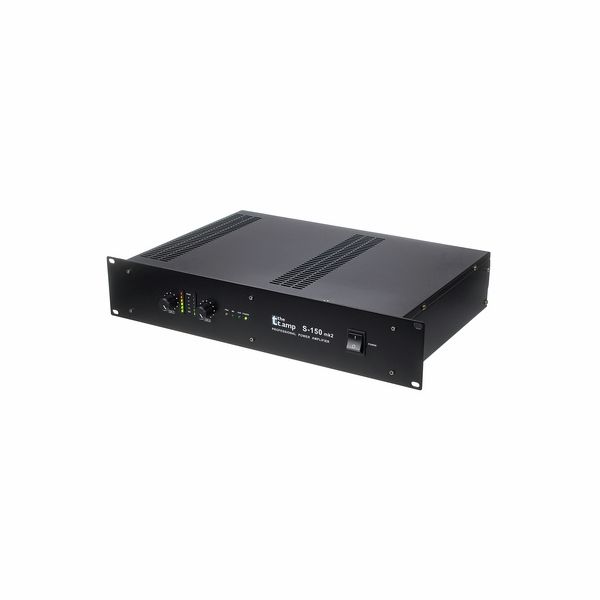Power amplifier
- 2 x 150 W at 4 ohms
- 2 x 85 W at 8 ohms
- Balanced inputs with XLR and jack
- Bridgeable
- Speaker Twist and binding post outputs for LS Out
- All protection circuits including Softstart
- Switchable input sensitivity of 0.775 Vrms to 1.4 Vrms, or can be switched to 26 dB Gain
- Damping factor > 150
- Convection cooled (no fan)
- 19", 2U, depth 32 cm (without handles)
- Weight 11.5 kg
Precise and linear
The S-150 MK II is a high-quality two-channel power amplifier that sets the standard for systems in this price range. Developed by Thomann’s in-house brand, the t.amp, the S-150 MK II’s linear frequency response, low self-noise and distortion, and generous power output will doubtless have sound enthusiasts sitting up and taking notice. Since the amplifier is convection-cooled (meaning no noisy fan is installed), it runs silently too. The S-150 MK II provides plenty of flexibility and connectivity for input/output configurations, including a handy “input sensitivity” switch, which, among other things, allows several amps to be combined to the same output level.
:format(jpeg))
Versatile and functional
The S-150 MK II is class AB amplifier with built-in limiters. Its maximum output is 250W (in “bridge mode”, at 8 ohms) with a damping factor of over 150dB. As previously mentioned, it features a quiet convection-cooling system. The rear connection panel offers a choice of balanced 6.35mm jack or XLR inputs, and “Speaker Twist” or binding outputs. The “input sensitivity” selector allows users to switch between 0.77V/RMS and 1.4V/RMS, while the 26dB setting matches the output levels of each amp when they are combined. The S-150 MK II is a 2RU rack-mountable unit (measuring 483×320×88mm) and weighs a reassuring 11.5kg. It features three operating modes – “Stereo” and “Parallel”, which operate at 2x85W at 8 ohms and 2x150W at 4 ohms, and “Bridge” mode, which allows the user to double the input channels to a single output and provides 250W of power at an impedance of 8 ohms.
:format(jpeg))
For monitoring and listening
The S-150 MK II’s linear and “unadulterated” sound makes it a good candidate for passive monitoring systems in the studio (the silent heat sink will be appreciated here, and the variety of inputs and outputs are all of professional quality). Hi-fi enthusiasts looking to “level up” should also be looking at this amplifier (with adapted speakers of course). If the amp has to be placed in an inconvenient or out-of-reach location, whether for practical or esthetical reasons, a handy ERP switch automatically puts the amplifier in standby mode after 20 minutes of inactivity.
:format(jpeg))
About the t.amp
the t.amp is one of the many in-house brands belonging to Musikhaus Thomann, and since 1998 has offered power amplifiers, complete passive PA sets, keyboard amplifiers, and connection systems. The brand’s entire product range delivers an impressive combination of quality and reliability at attractive prices, and users can find a convincing and affordable solution for every application: From youth clubs and sports halls through to congress centres and much more.
Installation and connection made easy
The S-150 MK II can simply be stood on its rubber feet, or, alternatively, it can be mounted in a 19" rack, which of course provides the best protection. In this case, it is advisable to leave a 1RU space free above the amp in order to ensure good airflow. All the inputs and outputs are at the back of the amplifier. As mentioned previously, the S-150 MK II has three operating modes. In Stereo mode, both channels remain independent, and the outputs can be individually controlled; in Parallel mode, the two input channels receive the same signal on channel 1 and both outputs are controlled by channel 1; finally, in Bridge mode, the two input channels are connected so that the output is doubled. Only the input on channel 1 is amplified and the output volume is also controlled on channel 1.












